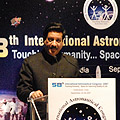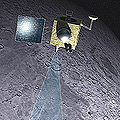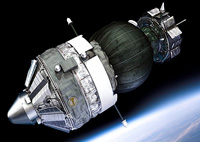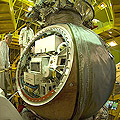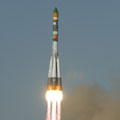Written by Tammy Plotner

Monday, September 24 - In 1970, the first unmanned, automated return of lunar material to the Earth occurred on this day when the Soviet's Luna 16 returned with three ounces of the Moon. Its landing site was eastern Mare Fecunditatis. Look just west of the bright patch of Langrenus.
Tonight our primary lunar study is crater Kepler. Look for it as a bright point, slightly lunar north of center near the terminator. Its home is the Oceanus Procellarum - a sprawling dark mare composed primarily of dark minerals of low reflectivity (albedo) such as iron and magnesium. Bright, young Kepler will display a wonderfully developed ray system. The crater rim is very bright, consisting mostly of a pale rock called anorthosite. The "lines" extending from Kepler are fragments that were splashed out and flung across the lunar surface when the impact occurred. The region is also home to features known as "domes" - seen between the crater and the Carpathian Mountains. So unique is Kepler's geological formation that it became the first crater mapped by U.S. Geological Survey in 1962.
Tuesday, September 25 - Tonight Uranus will be a little less than two degrees south of the Moon, but we're going to have a look at a lunar feature that goes beyond simply incredible - it's downright weird. Start your journey by identifying Kepler and head due west across Oceanus Procellarum until you encounter the bright ring of crater Reiner. Spanning 30 kilometers, this crater isn't anything in particular - just shallow-looking walls with a little hummock in the center. But, look further west and a little more north for an anomaly - Reiner Gamma.
Well, it's bright. It's slightly eye-shaped. But what exactly is it? Possessing no real elevation or depth above the lunar surface, Reiner Gamma could very well be an extremely young feature caused by a comet. Only three other such features exist - two on the lunar far side and one on Mercury. They are high albedo surface deposits with magnetic properties. Unlike a lunar ray of material ejected from below the surface, Reiner Gamma can be spotted during the daylight hours - when ray systems disappear. And, unlike other lunar formations, it never casts a shadow.
Reiner Gamma also causes a magnetic deviation on a barren world that has no magnetic field. This has many proposed origins, such as solar storms, volcanic gaseous activity, or even seismic waves. But, one of the best explanations for its presence is a cometary strike. It is believed that a split-nucleus comet, or cometary fragments, once impacted the area and the swirl of gases from the high velocity debris may have somehow changed the regolith. On the other hand, ejecta from an impact could have formed around a magnetic "hot spot," much like a magnet attracts iron filings.
No matter which theory is correct, the simple act of viewing Reiner Gamma and realizing that it is different from all other features on the Moon's earthward facing side makes this journey worth the time!
Wednesday, September 26 - This is the Universal date the Moon will become Full and it will be the closest to the Autumnal Equinox. Because its orbit is more nearly parallel to the eastern horizon, it will rise at dusk for the next several nights in a row. On the average, the Moon rises about 50 minutes later each night, but at this time of year it's around 20 minutes later for mid-northern latitudes and even less farther north. Because of this added light, the name "Harvest Moon" came about because it allowed farmers more time to work in the fields.
Often times we perceive the Harvest Moon as being more orange than at any other time of the year. The reason is not only scientific enough - but true. Coloration is caused by the scattering of the light by particles in our atmosphere. When the Moon is low, like now, we get more of that scattering effect and it truly does appear more orange. The very act of harvesting itself produces more dust and often times that coloration will last the whole night through. And we all know the size is only an "illusion"…
So, instead of cursing the Moon for hiding the deep sky gems tonight, enjoy it for what it is…a wonderful natural phenomenon that doesn't even require a telescope!
And if you'd like to visit another object that only requires eyes, then look no further than Eta Aquilae one fist-width due south of Altair…
Discovered by Pigot in 1784, this Cepheid-class variable has a precision rate of change of over a magnitude in a period of 7.17644 days. During this time it will reach of maximum of magnitude 3.7 and decline slowly over 5 days to a minimum of 4.5… Yet it only takes two days to brighten again! This period of expansion and contraction makes Eta very unique. To help gauge these changes, compare Eta to Beta on Altair's same southeast side. When Eta is at maximum, they will be about equal in brightness.
Thursday, September 27 - Tonight we'll begin with an easy double star and make our way towards a more difficult one. Beautiful, bright and colorful, Beta Cygni is an excellent example of an easily split double star. As the second brightest star in the constellation of Cygnus, Albireo lies roughly in the center of the "Summer Triangle" making it a relatively simple target for even urban telescopes.
Albireo's primary (or brightest) star is around magnitude 4 and has a striking orangish color. Its secondary (or B) star is slightly fainter at a bit less than magnitude 5, and often appears to most as blue, almost violet. The pair's wide separation of 34" makes Beta Cygni an easy split for all telescopes at modest power, and even for larger binoculars. At approximately 410 light-years away, this colorful pair shows a visual separation of about 4400 AU, or around 660 billion kilometers. As Burnham noted, "It is worth contemplating, in any case, the fact that at least 55 solar systems could be lined up, edge-to-edge, across the space that separates the components of this famous double!"
Now let's have a look at Delta. Located around 270 light-years away, Delta is known to be a more difficult binary star. Its duplicity was discovered by F. Struve in 1830, and it is a very tough test for smaller optics. Located no more than 220 AU away from the magnitude 3 parent star, the companion orbits anywhere from 300 to 540 years and is often rated as dim as 8th magnitude. If skies aren't steady enough to split it tonight, try again! Both Beta and Delta are on many challenge lists.
Friday, September 28 - Tonight we'll have a look at the central star of the "Northern Cross" - Gamma Cygni. Also known as Sadr, this beautiful main sequence star lies at the northern edge of the "Great Rift." Surrounded by a field of nebulosity known as IC 1310, second magnitude Gamma is very slowly approaching us, but still maintains an average distance of about 750 light-years. It is here in the rich, starry fields that the great dust cloud begins its stretch toward southern Centaurus - dividing the Milky Way into two streams. The dark region extending north of Gamma towards Deneb is often referred to as the "Northern Coalsack," but its true designation is Lynds 906.
If you take a very close look at Sadr, you will find it has a well-separated 10th magnitude companion star, which is probably not related - yet in 1876, S. W. Burnham found that it itself is a very close double. Just to its north is NGC 6910, a roughly 6th magnitude open cluster which displays a nice concentration in a small telescope. To the west is Collinder 419, another bright gathering that is nicely concentrated. South is Dolidze 43, a widely spaced group with two brighter stars on its southern perimeter. East is Dolidze 10, which is far richer in stars of various magnitudes and contains at least three binary systems.
Whether you use binoculars or telescopes, chances are you won't see much nebulosity in this region - but the sheer population of stars and objects in this area makes a visit with Sadr worthy of your time!
Saturday, September 29 - Tonight let's head about a fingerwidth south of Gamma Cygni to have a look at an open cluster well suited for all optics - M29.
Discovered in 1764 by Charles Messier, this type D cluster has an overall brightness of about magnitude 7, but isn't exactly rich in stars. Hanging out anywhere from 6000 to 7200 light-years away, one would assume this to be a very rich cluster and it may very well have hundreds of stars - but their light is blocked by a dust cloud a thousand times more dense than average.
Approaching us at around 28 kilometers per second, this loose grouping could be as old as 10 million years and appears much like a miniature of the constellation of Ursa Major at low powers. Even though it isn't the most spectacular in star-rich Cygnus, it is another Messier object to add to your list!
Sunday, September 30 - Today in 1880, Henry Draper must have been up very early indeed when he took the first photo of the Great Orion Nebula (M42). Although you might not wish to set up equipment before dawn, you can still use a pair of binoculars to view this awesome nebula! You'll find Orion high in the southeast for the Northern Hemisphere, and M42 in the center of the "sword" that hangs below its bright "belt" of three stars.
Tonight before the Moon rises and we leave Cygnus for the year, try your luck with IC 5070, also known as the "Pelican Nebula." You'll find it just about a degree southeast of Deneb and surrounding the binary star 56 Cygni.
Located around 2000 light-years away, the Pelican is an extension of the elusive North American Nebula, NGC 7000. Given its great expanse and faintness, catching the Pelican does require clean skies, but it can be spotted best with large binoculars. As part of this huge star forming region, look for the obscuring dark dust cloud Lynds 935 to help you distinguish the nebula's edges. Although it is every bit as close as the Orion Nebula, this star hatchery isn't quite as easy!

